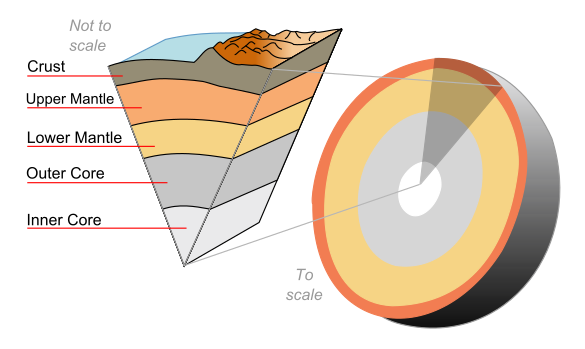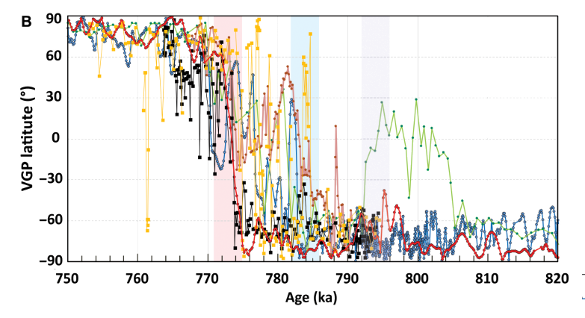Magnetic Pole Flip
October 21, 2019
One of the mysteries about
zombies is that they move so slowly, but people still can't seem to escape.
George A. Romero initiated the
slow motion zombie
stereotype in his 1968
film,
Night of the Living Dead.[1] It seems
logical that a
reanimated corpse should be somewhat
lethargic, and Romero may have been influenced in his zombie characterization by the 1932 classic,
The Mummy.[2] The plodding motions of
Boris Karloff in playing the
mummy of Imhotep is much like that of a zombie.

The Egyptian Book of the Dead was a collection of incantations intended to assist the deceased's journey into the afterlife. This book was not fixed text; rather, it was augmented by priests over the course of many centuries.
In this detail from the 1275 BC Book of the Dead of Hunefer, sheet 3, Osiris sits on his throne, with the goddesses, Isis and Nephthys, behind him. The four Sons of Horus are standing on a large lotus.
(British Museum Accession number EA 9901, via Wikimedia Commons
Our
modern culture has a need for speed. One
mantra of my time in
corporate research was "
first to market," the idea that your
invention would be far more
profitable if it was sold at an early stage of
development rather than waiting for a more perfect
product. Not surprisingly, we have many expressions about maddeningly slow processes, such as
watching grass grow and
watching paint dry However, few processes are as slow as
geological processes such as
glacial flow (watch it
while they're still here) and the movement of
tectonic plates.
Hillside creep never excited me, I'm not a
geologist or a
geophysicist, but I've always had an interest in the
magnetic moment of the
Earth. The direction of
Earth's magnetic field, like other geological
phenomena, changes slowly over time. As I discussed in a
recent article (Magnetic North, February 11, 2019), the Earth's
North Magnetic Pole is not as fixed as
navigators would prefer. Although the position of the North magnetic pole was fairly constant for most of the
20th century, it's presently moving at about 30
miles (50
kilometers) per year.[3-4] We're only now capable of measuring magnetic pole movement as it happens, so
geoscientists are starting to wonder whether such excursions are a prelude to something more dramatic.
Such could be expected by the manner in which the Earth's magnetic field is generated.
Dynamo action of
liquid iron in its
core produces Earth's magnetic field, and the complexity of
fluid dynamics leads to the variation that we observe. At times there's a reversal of the
fluid flow that causes a
geomagnetic reversal of the
magnetic polarity with the north-south direction being reversed and
compass needles pointing the other way. These
geomagnetic reversals have happened often in
Earth's history (see figure).

Geomagnetic reversals for the last five million years (Mya), as revealed by the Geological record. The blue areas mark when the polarity was the same as our present North-South polarity. (Data from U.S. Geological Survey Open-File Report 03-187, as converted by Intgr to a Wikimedia Commons image and modified for clarity. Click for larger image.)
Since Earth's magnetic field protects its
living organisms from
cosmic rays, is there a greater incidence of
extinction events during reversals? Research has shown no extinction events during geomagnetic reversals. A study found that the Earth's magnetic field decreased by just 5% during the short (440
year)
Laschamp reversal event that occurred 41,400 ± 2,000 years ago.[5]
Evidence of pole flips is encoded in magnetic
minerals in
lava flows. When a
ferromagnet or
ferrimagnet is
heated above its
Curie temperature, it loses its magnetism. The magnetism returns when the material cools again, and the magnetic axis of the mineral
crystallites aligns to the direction of Earth's magnetic field at the time. Another technique,
magnetostratigraphy examines magnetism in
sedimentary materials, since magnetized
grains will preferentially orient themselves with Earth's magnetic field.
The pole reversals are
statistically random, and 183 reversals have been recorded over the last 83 million years. It appears that pole reversal is a slow process with an average duration of about 7,000 years. There have been much shorter flips, called
excursions because of their fleeting nature. One of these is the
Laschamp excursion that occurred about 41 thousand years ago. A recent study of the most recent pole reversal that occurred about 773 thousand years ago shows that the duration of this flip was much longer, about 22,000 years.[6-8]

Cross-section of the Earth. The inner core, which is about 20% of the Earth's radius, is solid because of pressure, but the outer core is a liquid composed mostly of iron and nickel about 1,500 miles (2,400 kilometers) thick. Rotation of the outer core causes the Earth's magnetic field. (Modified Wikimedia Commons image by Surachit.)
This new research by a team from the
University of Wisconsin-Madison (Madison, Wisconsin),
Kumamoto University (Kumamoto, Japan), and the
University of California, Santa Cruz (Santa Cruz, California) took a careful look at the
Brunhes-Matuyama reversal, the geomagnetic transition that happened around 780,000 years ago.[7] One
theory of such polarity reversals is that they are caused by an inbalance between the rotation of the Earth and the
temperature at
Earth's core, and this alters the
fluid dynamics of its
liquid iron.[7] To accurately pinpoint the magnetic state during this transition, the research team used data from several sources of
historical information about Earth's magnetism during this period, including new techniques for dating solidified lava.[7-8]
The
ratio of
40Ar to
39Ar was used as a date reference for magnetized lava flows,
ocean sediment and
ice cores having a record of Earth's magnetism.[6-7]
Basaltic lava contains
magnetite, and the the magnetization direction of this
ferrous material gets locked into place upon cooling.[7] Since lava flows are scarce, the researchers looked also at magnetized ocean sediments and
Antarctic ice cores.[7] Antarctic ice cores also contain a
beryllium isotope that forms under cosmic radiation, and that happens when Earth's magnetic field weakens during an excursion or reversal.[7]
While earlier estimates of the duration of a field reversal were between 4,000 and 9,000 years, the present study found that the Brunhes-Matuyama reversal took roughly 22,000 years to complete.[8] The data also reveal that the reversal started with an excursion, in which Earth's field dropped significanty but did not reverse.[8] Reversal was accomplished 11,000 years after the excursion, with a final settling of the field that lasted 4,000 years.[8] Says
Brad S. Singer, first
author of the
paper and a geoscientist at the University of Wisconsin-Madison, "What the lava-flow records show clearly are a couple of attempts by the dynamo to reverse polarity that took place prior to the final culminating reversal."[8]

Fortunately, my laboratory data were never as complicated as this, but nature is not a controlled experiment. This is a graph showing the high–deposition rate ocean sediment records of the virtual geomagnetic pole (VGP) evolution associated with the Brunhes-Matuyama reversal as a function of time. The final polarity reversal at about 773 ka was the culmination of a process that began at about 795 ka with weakening of the magnetic field,followed by an excursion and another weakening of field at about 784 ka.[6] (Fig. 3B 0f ref. 6, distributed under a Creative Commons Attribution NonCommercial License 4.0 (CC BY-NC))[6]
As Singer notes, "Our study points to a more protracted and complex process for driving and propelling a geomagnetic field reversal."[8] For the past two centuries, Earth’s magnetic field has decayed at a rate of five percent each century, as if indicative of a pending field reversal, but Singer thinks that a reversal will not likely happen for the next two
millennia, so
humanity will have time to
shield its
technologies, such as
satellites, from
cosmic radiation by the time of the next reversal.[7]
"It may be that you have to weaken the field for several thousand years in order to get a reversal because the inner core is solid... If you turn off the magnetic field in the liquid outer core, there's magnetic energy inside the solid inner core that takes several thousand years to leave. What we're seeing now with the north pole moving rapidly, that’s actually quite normal.. The actual reversal, the final reversal, takes several thousand years."[7-8]
References:
- Night of the Living Dead (1968, George A. Romero, Director) on the Internet Movie Database.
- The Mummy (1932, Karl Freund, Director) on the Internet Movie Database.
- Alexandra Witze, "Earth’s magnetic field is acting up and geologists don’t know why," Nature, vol. 565 (January 9, 2019), pp. 143-144, doi: 10.1038/d41586-019-00007-1.
- Alister Doyle, "Shifting north magnetic pole forces unprecedented navigation fix," Reuters, January 11, 2019.
- N.R. Nowaczyk, H.W. Arz, U. Frank, J. Kind, and B. Plessen, "Dynamics of the Laschamp geomagnetic excursion from Black Sea sediments," Earth and Planetary Science Letters, Vols. 351-352 (October 15, 2012), pp. 54-69.
- Brad S. Singer, Brian R. Jicha, Nobutatsu Mochizuki, and Robert S. Coe, "Synchronizing volcanic, sedimentary, and ice core records of Earth’s last magnetic polarity reversal," Science Advances, vol. 5, no. 8 (August 7, 2019), Article no. eaaw4621, DOI: 10.1126/sciadv.aaw4621. This is an open access article with a PDF file here
- Emily Toomey, "Earth’s Magnetic Field Could Take Longer to Flip Than Previously Thought," Smithsonian.com, August 7, 2019.
- Jonathan O'Callaghan, "Earth’s Magnetic Field Reversal Took Three Times Longer Than Thought," Scientific American, August 7, 2019.
Linked Keywords: Zombie; George A. Romero; slow motion; stereotype; film; Night of the Living Dead; logic; logical; reanimated; cadaver; corpse; lethargy; lethargic; The Mummy (1932 film); Boris Karloff; Imhotep (The Mummy); Egyptian Book of the Dead; incantation; death; deceased; afterlife; priest; century; Osiris; throne; goddess; Isis; Nephthys; Sons of Horus; Nelumbo nucifera; lotus; British Museum; Wikimedia Commons; modern history; culture; mantra; corporation; corporate research; first-mover advantage; first to market; invention; profit; profitable; development; product (business); geology; geological; glacier; glacial; ice-sheet dynamics; flow; retreat of glaciers; tectonic plate; downhill creep; Hillside creep; geologist; geophysicist; magnetic moment; Earth; Earth's magnetic field; phenomenon; North Magnetic Pole; navigator; 20th century; mile; kilometer; Earth science; geoscientist; dynamo theory; Dynamo action; liquid; iron; outer core; fluid dynamics; hydrodynamics; fluid flow; geomagnetic reversal; magnetic polarity; compass needle; geologic time scale; Earth's history; Mya; geological record; >polarity; U.S. Geological Survey; Open-File Report 03-187; User:Intgr; life; living; organism; cosmic rays; extinction event; year; Laschamp reversal event; mineral; lava flow; ferromagnet; ferrimagnet; heat; heated; Curie temperature; crystallite; magnetostratigraphy; sedimentary; grain; statistics; statistical; randomness; random; Laschamp excursion; cross-section (geometry); inner core; Earth's radius; solid; pressure; Earth's outer core; liquid; iron; nickel; rotation; Earth's magnetic field; User:Surachit; University of Wisconsin-Madison (Madison, Wisconsin); Kumamoto University (Kumamoto, Japan); University of California, Santa Cruz (Santa Cruz, California); Brunhes-Matuyama reversal; theory; temperature; Earth's core; historical; ratio; pelagic sediment; ocean sediment; ice cores; basalt; basaltic; magnetite; ferrous; material; Antarctic; beryllium; isotope; Brad S. Singer; author; scientific literature; paper; laboratory; data; nature; controlled experiment; Cartesian coordinate system; graph; virtua; geomagnetic pole; Creative Commons Attribution NonCommercial License 4.0 (CC BY-NC); millennium; millennia; human; humanity; electromagnetic shielding; shield; technology; satellite; cosmic radiation; energy.